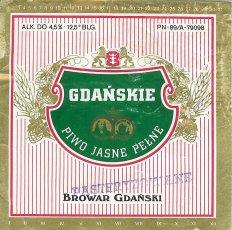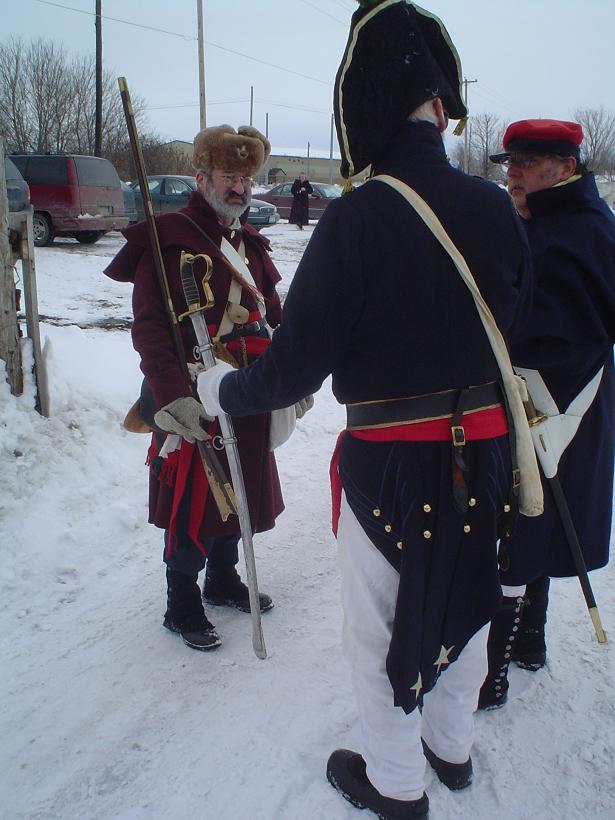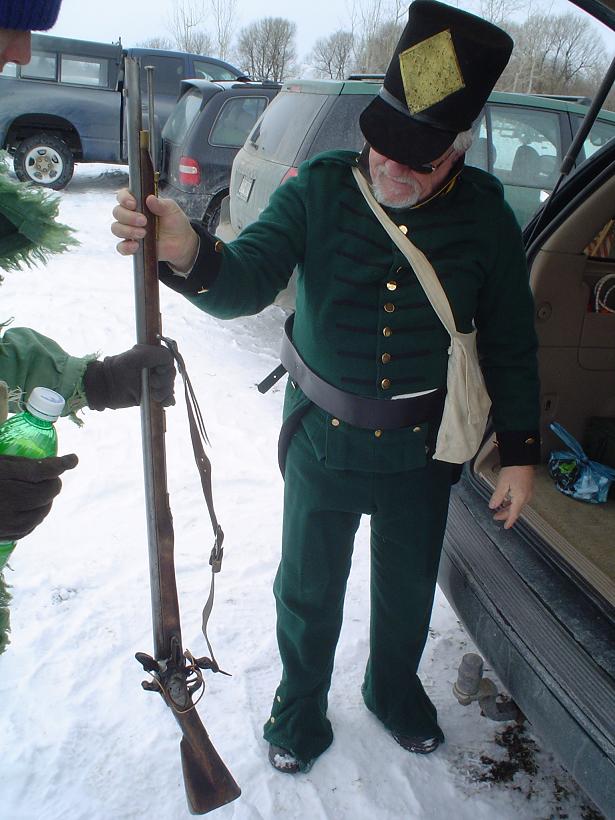America is grey line on the horizon beyond Wolfe Island to the south east as viewed from the mouth of the Little Cataraqui River. The highlands, beyond Watertown, in the south-east of Jefferson County, New York, fifty some miles away, rise to 1,500 feet and form the western edge of the Adirondacks.
Category: Me and Mine
Martello Towers
Martello towers guard the mouth of the Rideau. There are actually three in the picture, the third hidden by the trees to the left. It stands out in the mist better here. Built in the 1840s to protect the then high-tech canal technology of the Rideau accessed between the nearest two towers, the theory was similar to Halifax Harbour’s defences – a killing zone of miles deterring any thought of attack. One gun in the red roofed tower to the left had a range of 7 miles. Greater detail and a harbour map can be found here.
Less Ice, More Water
Wuzza Hot?
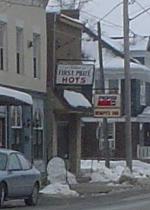 So we are back from being over the border, having had a great time. I took some movies to be posted later of the Battle of Ogdensburg recreation which are fairly neat – if seeing grown men dressed up funny shooting cannon within town limits is cool to you.
So we are back from being over the border, having had a great time. I took some movies to be posted later of the Battle of Ogdensburg recreation which are fairly neat – if seeing grown men dressed up funny shooting cannon within town limits is cool to you.
But as I was driving through east end Ogdensburg, New York, I noticed this. What is a “Hot” that you could win first prize for? The particular outlet for them is called Whimpy’s Inn.
Gdansk
Roaming through .jpg files just now I came across this beer label from 1991 in Poland where semi-attentive readers are aware I lived. Buying beer in Eastern Euope then was hit and miss. Local families, in our district of new suburbs, ran shops out of their bottom floors and the beers for sale were those Pan Sklepu would go and get. Supply lines were a bit erratic as a result. So happy were the days when Pivo Gdanskie would show up as opposed to some rot from Slupsk which used cloves instead of hops – but only on some weeks when their hops supply didn’t come through. Nothing as refreshing as the surprise of a bubbly mouthful of cloves.
Battle of Ogdensburg
We are heading over to beautiful Ogdensburg, 100 km down river on the USA side, for the 14th. Beats the hell out of the Valentine’s Day when myself and herself were amazed at the easy access to the coin laundry machines before we remembered the date.
It is not the reopening of the cheese plant that attracts us. No. It’s the nutty recreationists dressing up like 1812 soldiers for the annual Battle of Ogdensburg re-enactment. Here is the contemporary British view of events. Apparently a group of Newfoundlanders were key to the victory. Here is an American perspective. Pretty big battle with 800 redcoats involved on a direct attack on a US village and fort. Here is a map of the battle. Canadian re-enactors as well as US take part. The area had a mid-1700s French presence and only became the USA in 1796 when the British retreated after the Jay Treaty.
Later St. Lawrence University will play host to Vermont at Canton in NCAA hockey – fewer guns but more real fights.
Men at Serious Play
So we went over to St. Lawrence County, New York, on Saturday to catch a War of 1812 re-enactment of the Battle of Ogdensburg organized by a local group, Forsyth’s Rifles Inc.. We were not disappointed. I had never been to one of these things before – other than being a mock soldier at Citidel Hill in Halifax for one day (I got sun stroke in the shade) – and so in had some pre-conceptions that, on one hand, it would be like a radio nerd convention and, on the other, a bit gungho.
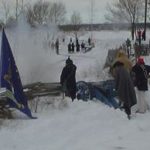 It was neither. About 60 guys, who could very well have been all high school history from either side of the river/border, played out the actual battle with some authenticity for over about an hour. They were quite happy to answer all questions and made sure everyone kep a safe distance. The grey-coated British advanced over the ice in formation, cannons roared from both sides and fifes were played. It was quite cold and a couple guys said they were considering taking Walmart and holding it instead.
It was neither. About 60 guys, who could very well have been all high school history from either side of the river/border, played out the actual battle with some authenticity for over about an hour. They were quite happy to answer all questions and made sure everyone kep a safe distance. The grey-coated British advanced over the ice in formation, cannons roared from both sides and fifes were played. It was quite cold and a couple guys said they were considering taking Walmart and holding it instead.
I wrote earlier this month on the events and provided links in that post. A year later in the War of 1812, the USA invaded Eastern Ontario and got hammered at Chrysler’s Farm where a much smaller force protected Montreal against 8000 soldiers (including the real Forsyth’s unit) coming up the river from Sackett’s Harbor. There is a bigger re-enactment in summer of that battle which we will likely take in. The Ogdensburg guys head over for that.
Some short movies of the action – all around 2 Mbs so expect some delay
The fifes play as the battle nears
The US forces march out to meet the Brits
a US cannon fires
The US musketmen are ordered to fire at will – note small Brit snowshoe unit coming up to the left in trees
Please give me a heads up if any of the links in the multi-media post do not work.
Napanee
Good Planning
Pub, Art, Hair, Curry, Texmex. I like this block – kitty corner to S&R – which incorporates a 1870’s firehall, some limestones a few decades older as well as a new brick build with a hair place that fits in the scheme. Next to it, tucked behind down the alley to the right is Curry Village, one of the great Indian restaurants in the downtown. Behind to the left you’ll see a Holiday Inn which was built on an old wharf like others in the downtown – rather than on land occupied by historic buildings. At the intersection, Cornerstone is a private art gallery with Inuit art among other things. The 1876 firehall half shown to the right of the picture is a Lonestar. To the left, the newish pub Merchant MacLiam built in the last year or two fills the oldest space in the scene, an 1840 warehouse with a very similar build to Halifax’s Lower Deck with more of a Middle Deck crowd. The pub, curry and texmex all meet in patios at the back with view of the river.
The Barachois is Claimed!
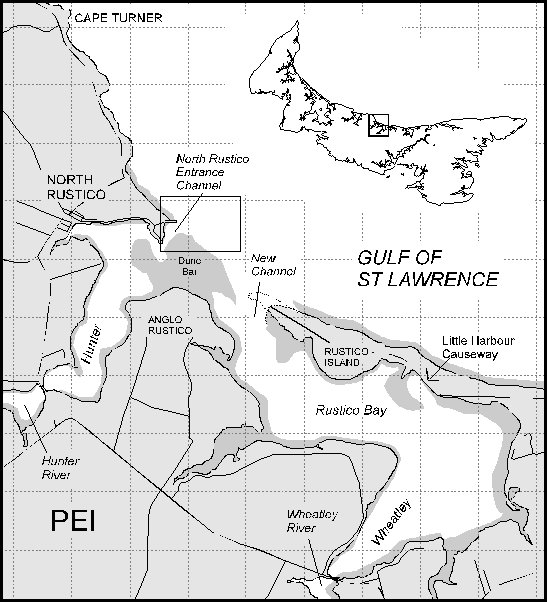 I used to live a walk from the sand bar – or barachois in Acadian French – near North Rustico, PEI which is now being claimed by someone as ownable land. Funny until you remember the bit that is not covered by the tides twice a day is a nesting site for rare plovers. Thank God we can rest easy knowing the top guns are on the case:
I used to live a walk from the sand bar – or barachois in Acadian French – near North Rustico, PEI which is now being claimed by someone as ownable land. Funny until you remember the bit that is not covered by the tides twice a day is a nesting site for rare plovers. Thank God we can rest easy knowing the top guns are on the case:
Lewie Creed is the deputy minister and says something will be done, he just hasn’t decided yet what that will be.
Beautiful. I have found this handy map and I think the area in question is that identified as “Dune Bar” above Anglo Rustico – that is the bit known locally as the barachois.
It is interesting to note the absence of South Rustico on the map as well as Rusticoville (not to mention Rustico Cross but we won’t get into that one) and the Hunter River is known as the Clyde River at that point of the flow. Hence the name Hunter-Clyde Watershed Group. Hunter River PEI and Hunter Valley Australia, home of plumy reasonably priced red wines, share a common history in that the same group settled each area and one named itself after the other (but I can’t recall which way it went).




